The Philippine Sailfin Lizard is a giant reptile species found in the Philippine Islands, known for its unique sail-like structure on its back. Growing up to 1.5 meters long, it primarily feeds on vegetation and is found near freshwater sources. However, habitat loss and illegal wildlife trade are significant threats to this species, emphasizing the need for conservation efforts.
This article will explore these lizards in greater detail, including their physical features, habitat and distribution, diet and feeding habits, behavior and social structure, reproduction, and life cycle, threats, conservation status, cultural significance, and folklore, as well as keeping them as pets.

Physical Characteristics and Appearance
The Philippine Sailfin Lizard, also known as the giant lizard of the Philippine Islands, is a stunning reptile that is native to the Philippines. These majestic creatures are known for their impressive size and unique physical characteristics that make them stand out from other lizards. Here, we will explore the physical characteristics and appearance of the Philippine Sailfin Lizard.
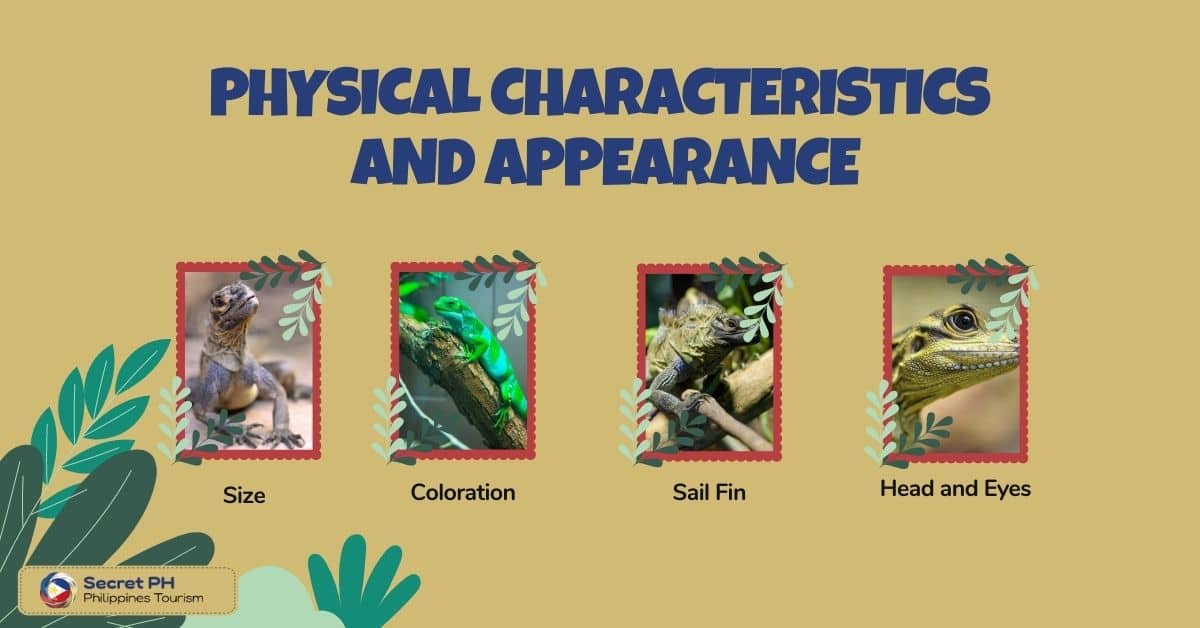
Size
One of the most notable physical features of the Philippine Sailfin Lizard is its size. These lizards can grow up to 1.5 meters or 5 feet in length, making them one of the largest lizards in the world. They have long and slender body that is covered in tough, scaly skin. Despite their large size, these lizards are agile and can move quickly when needed.
Coloration
The coloration of the Philippine Sailfin Lizard varies depending on the region where they are found. They have a base color of brown or green, but their bodies are covered in a pattern of stripes or spots that can be in shades of brown, yellow, or green. Their undersides are typically lighter in color and may have a yellow or white hue.
Sail Fin
The most distinctive physical characteristic of the Philippine Sailfin Lizard is its sail-like fin that runs along its back. This fin is made up of elongated spines that are attached to the lizard’s vertebral column.
When fully extended, the sail can reach up to twice the height of the lizard’s body, making it an impressive sight to see. The sail is typically a vibrant shade of yellow, orange, or green.
Head and Eyes
The head of the Philippine Sailfin Lizard is small in proportion to its body, and it has a distinctive large eye with a dark iris. Its eyes are located towards the front of its head, giving it binocular vision and allowing it to accurately judge distance. Their strong jaw and sharp teeth are perfectly designed for capturing prey.
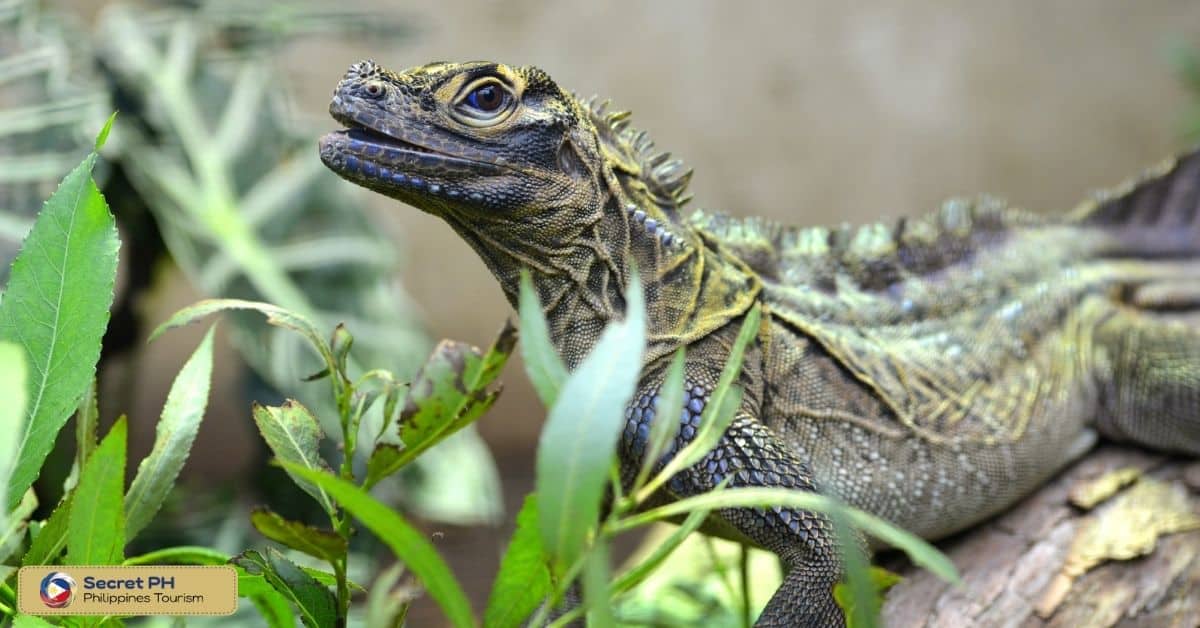
Habitat and Distribution
The Philippine Sailfin Lizard is known for its impressive size and unique physical characteristics, which has made it a popular subject of study among biologists and reptile enthusiasts alike. Understanding the habitat and distribution of this species is essential to its conservation and protection.
Habitat
The Philippine Sailfin Lizard inhabits a variety of environments, including rainforests, mangroves, and marshes. These lizards are primarily found near freshwater sources, such as rivers, streams, and ponds.
They spend much of their time near the water, basking in the sun on rocks or tree branches overhanging the water. The presence of water is crucial to their survival as it helps regulate their body temperature.
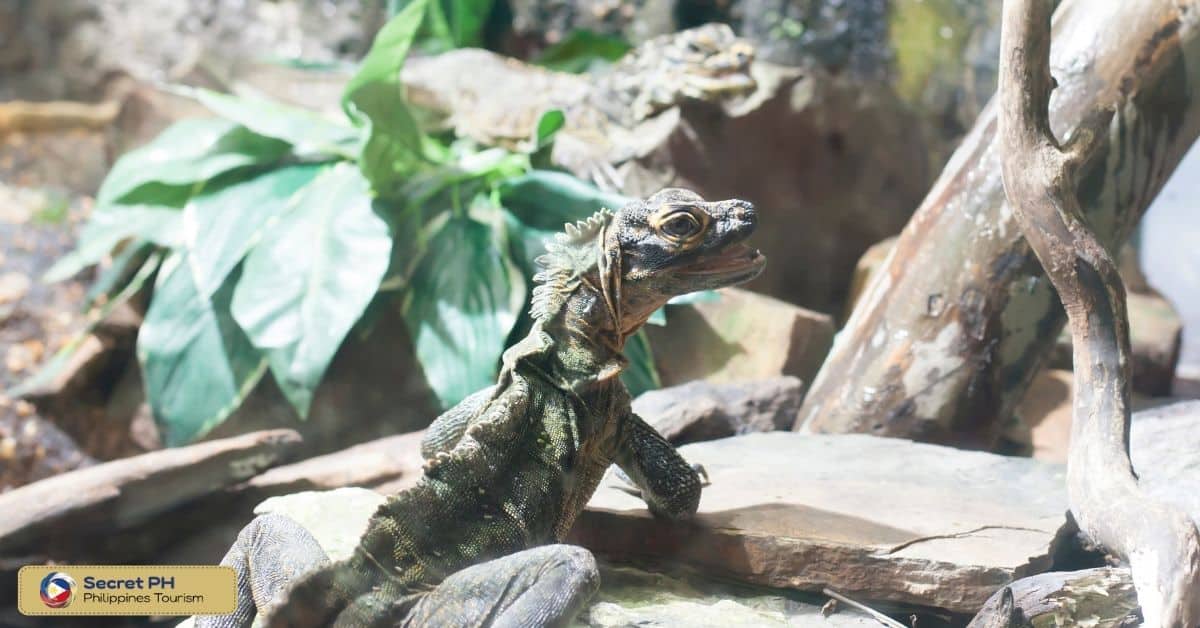
Distribution
The Philippine Sailfin Lizard is endemic to the Philippine Islands and is found throughout the archipelago. Including Luzon, Mindanao, Samar, Leyte, and several other islands. Within these islands, they are distributed in different habitats, such as lowland and montane forests, marshes, and agricultural areas.

Diet and Feeding Habits
In addition to its physical appearance, the Philippine Sailfin Lizard also has unique dietary and feeding habits that contribute to its survival in the wild. Understanding their diet and feeding habits is crucial to their survival and conservation.
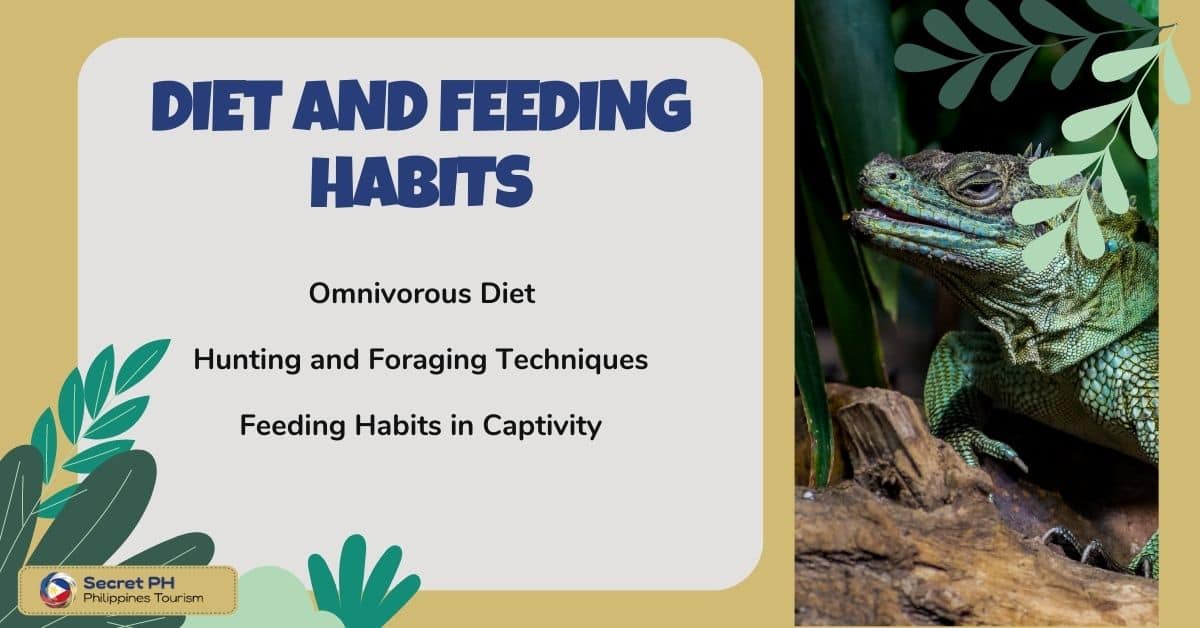
1. Omnivorous Diet– The Philippine Sailfin Lizard is an omnivorous reptile, which means that it can consume both plant and animal-based food sources. In the wild, these lizards will eat a variety of insects, spiders, and small vertebrates, such as frogs and lizards. They are also known to consume fruits, flowers, and leaves from various plants.
2. Hunting and Foraging Techniques– Due to their agility and size, the Philippine Sailfin Lizard has developed unique hunting and foraging techniques to acquire their food sources. They will climb trees and tall plants to reach their prey and use their long tongues and sharp teeth to capture insects and other small vertebrates.
3. Feeding Habits in Captivity– In captivity, the feeding habits of the Philippine Sailfin Lizard can vary depending on its environment and dietary needs. Although their diet consists of both plant and animal-based food sources, it is important to provide a balanced diet that is rich in vitamins and nutrients. Many owners will feed their lizards a combination of vegetables, fruits, and insects to ensure that their dietary needs are being met.
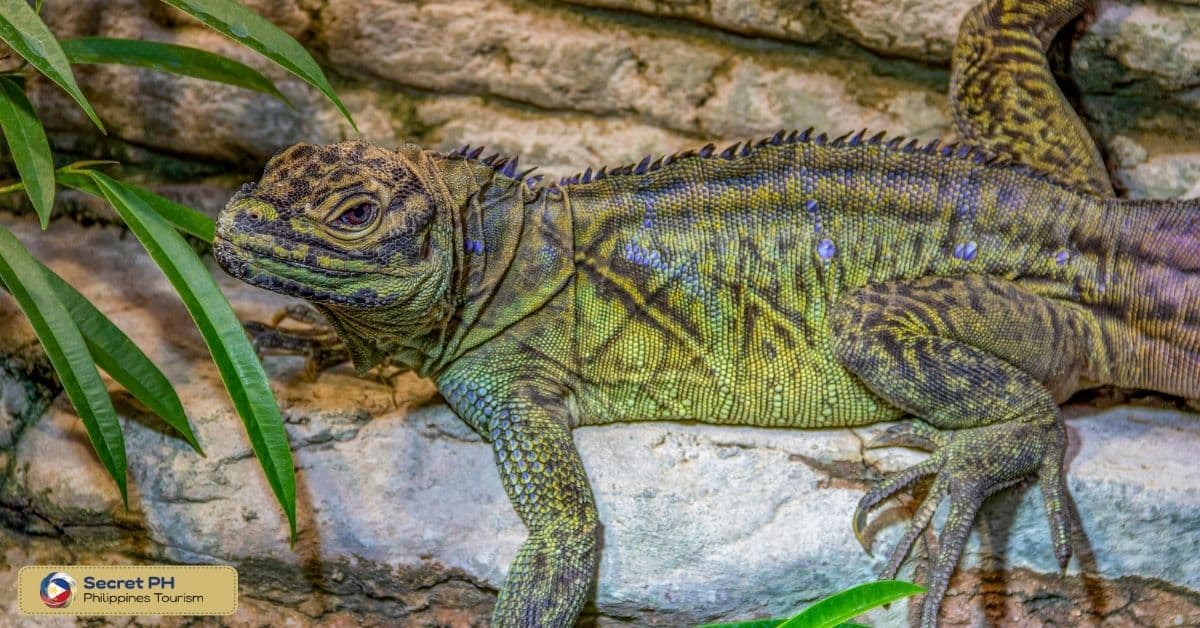
Behavior and Social Structure
Philippine Sailfin Lizards are fascinating creatures that exhibit a range of interesting behaviors and social structures. Understanding their behavior and social structure is essential to their conservation and protection.
Behavior
The Philippine sailfin lizard is a diurnal species, which means it is active during the day. These lizards are arboreal, meaning they live in trees and are excellent climbers. They are also good swimmers and can frequently be found near bodies of water.
Males are typically more territorial than females and will defend their territory against other males. They will also display a variety of behaviors such as head-bobbing and tail-lashing to intimidate potential threats.
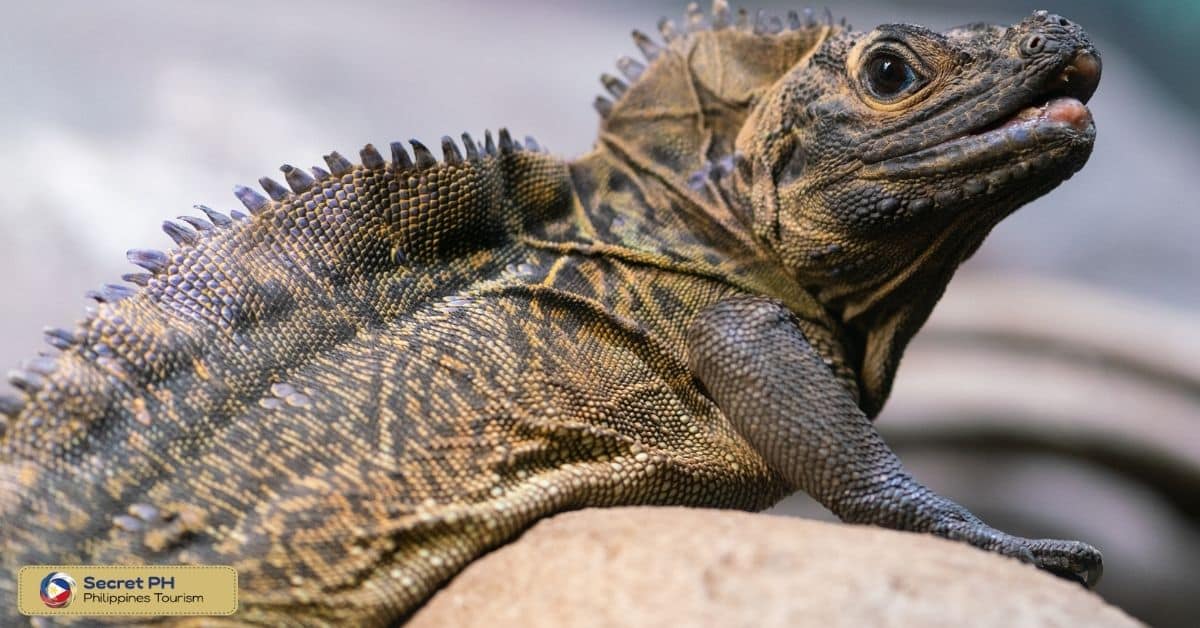
Social Structure
Philippine sailfin lizards are generally solitary animals, but they can form small groups or populations in areas where food and resources are abundant. These groups can consist of up to three or four individuals, and they will often share the same territory.
Males are known to display dominance over other males during mating season, but otherwise, they will not interact much with each other. Females will also maintain their own territories and will only tolerate the presence of a male during mating season.
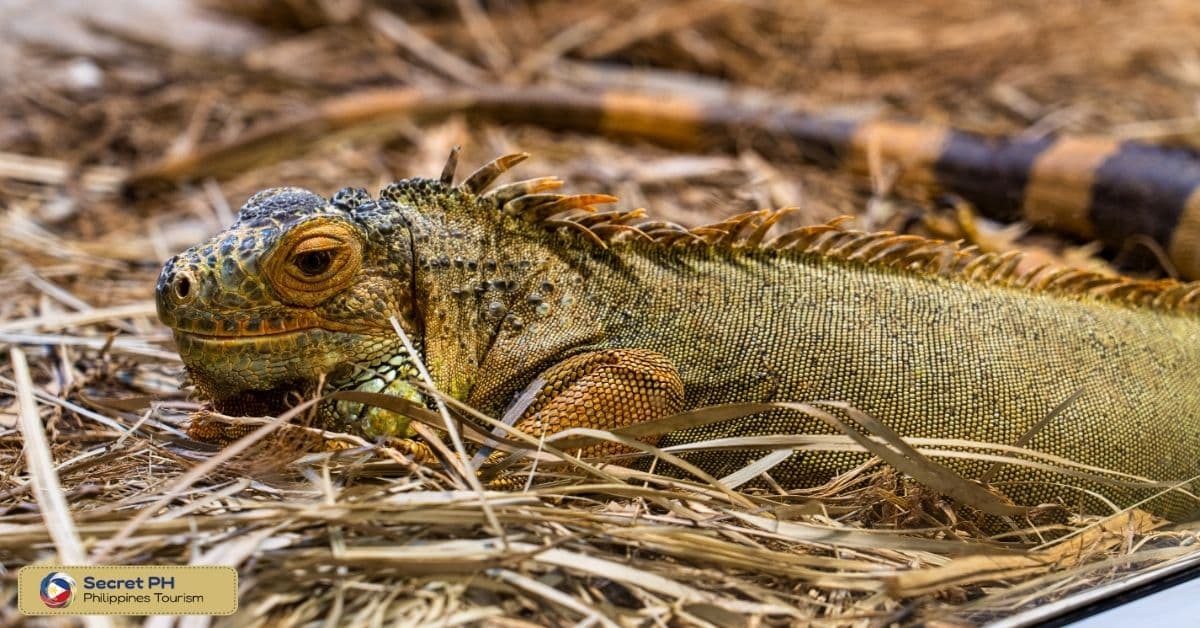
Reproduction and Life Cycle
The Philippine Sailfin Lizard, also known as the Giant Lizard of the Philippine Islands. A magnificent creature that inhabits the forests, mangroves, and coastal regions of the Philippine Islands.
Its majestic sail-like fin and vibrant coloration make it a popular exotic pet, but the species is also an important part of the ecosystem. Here, we will explore the fascinating reproduction and life cycle of this incredible species.
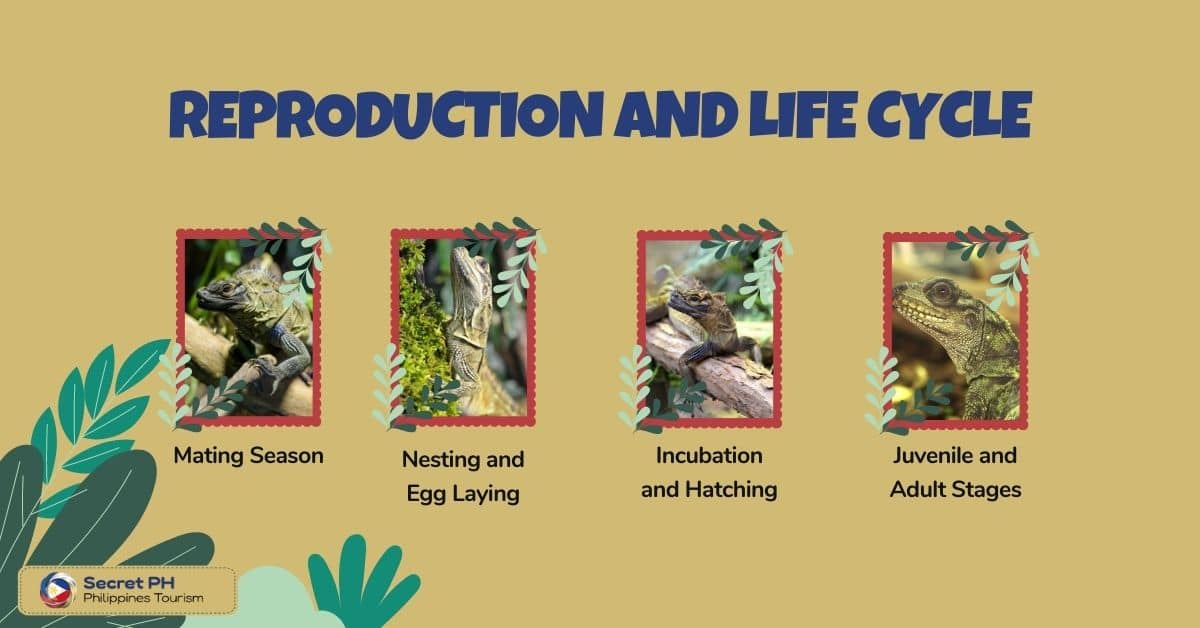
Mating Season
The Philippine Sailfin Lizard is a sexually dimorphic species, which means that males and females have distinct physical characteristics. During the breeding season, which occurs from January to March, males display their vibrant colors to attract a mate. They also engage in head-bobbing, tail-wagging, and other courtship behaviors to win the female’s acceptance.
Nesting and Egg Laying
After mating, the female will search for a suitable location to lay her eggs. She will dig a hole in the ground or in the base of a tree and lay a clutch of up to 13 eggs.
The eggs are oval-shaped and measure approximately 45-50 mm in length. The female will cover the eggs with soil or debris to protect them from predators.
Incubation and Hatching
The eggs will remain in the nest for approximately 70-80 days, depending on the temperature and humidity. During this time, the female will guard the nest and defend it against predators.
When the eggs are ready to hatch, the baby lizards will use an egg tooth to break open the shell. They emerge from the nest as miniature replicas of their parents, measuring approximately 80-90 mm in length.
Juvenile and Adult Stages
Juvenile lizards are vulnerable and must avoid predators such as birds, snakes, and other predators. They will remain close to their nest site for several days before venturing out into the surrounding environment.
As they grow, they will shed their skin periodically and gradually develop their distinctive sail-like fin. The Philippine Sailfin Lizard can live up to 12 years in the wild, and individuals that are well-cared for in captivity can live even longer.
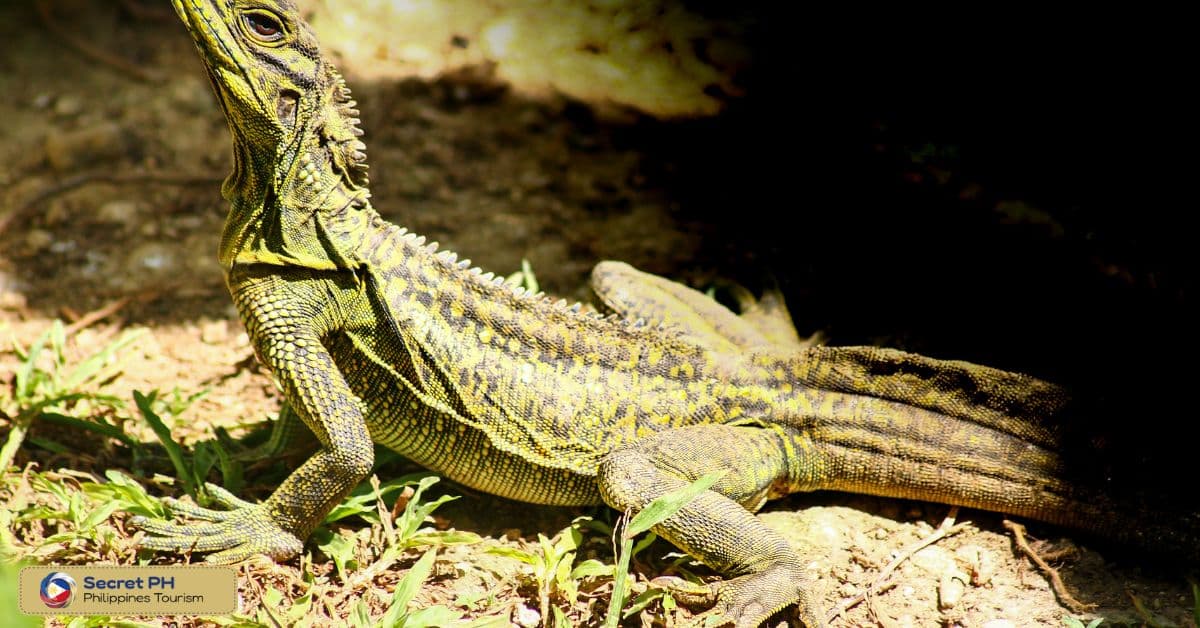
Threats and Conservation Status
The Philippine Sailfin Lizard has a unique appearance, massive size, and distinct habitat requirements, this species has become a subject of interest among biologists and conservationists. Unfortunately, the population of Philippine Sailfin Lizards is declining rapidly due to various threats. Here, we will discuss the major threats to this species and its conservation status.
Threats to the Philippine Sailfin Lizard
There are several threats to the Philippine Sailfin Lizard, including:
1. Habitat Loss– The forested areas of the Philippine Islands, where the Philippine Sailfin Lizard lives, are rapidly disappearing due to agricultural expansion, logging, and human settlements. As a result, the available habitat for the lizard is shrinking, which leads to decreased populations and increased pressure on the remaining individuals.
2. Illegal Wildlife Trade– The demand for exotic pets and animal parts remains high in many parts of the world, and the Philippine Sailfin Lizard is no exception. Despite legal protection, this species is still being captured and sold illegally in both national and international markets. This has led to a decline in the natural populations of the lizard.
3. Climate Change– Like other reptiles, the Philippine Sailfin Lizard is highly sensitive to changes in temperature and rainfall patterns. Climate change and global warming have resulted in significant changes in these factors, which can affect the survival rate of this species.
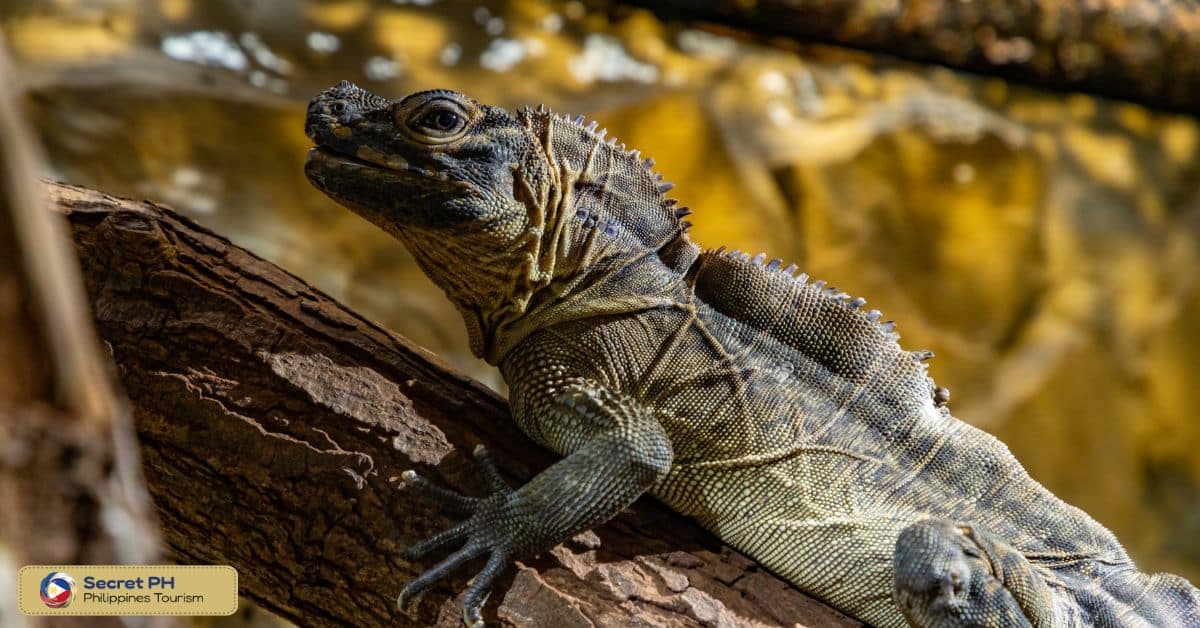
Conservation Status of the Philippine Sailfin Lizard
Several conservation programs are in place to protect the Philippine Sailfin Lizard. The Philippine government has listed this species as “Vulnerable” under their National List of Threatened Wildlife. It is also listed under Appendix II of the Convention on International Trade in Endangered Species of Wild Fauna and Flora (CITES), which regulates international trade in this species.
Several NGOs and conservation organizations are working towards protecting the habitat of the Philippine Sailfin Lizard. They are also working with local communities to reduce hunting and poaching and create awareness about the importance of conserving this species.
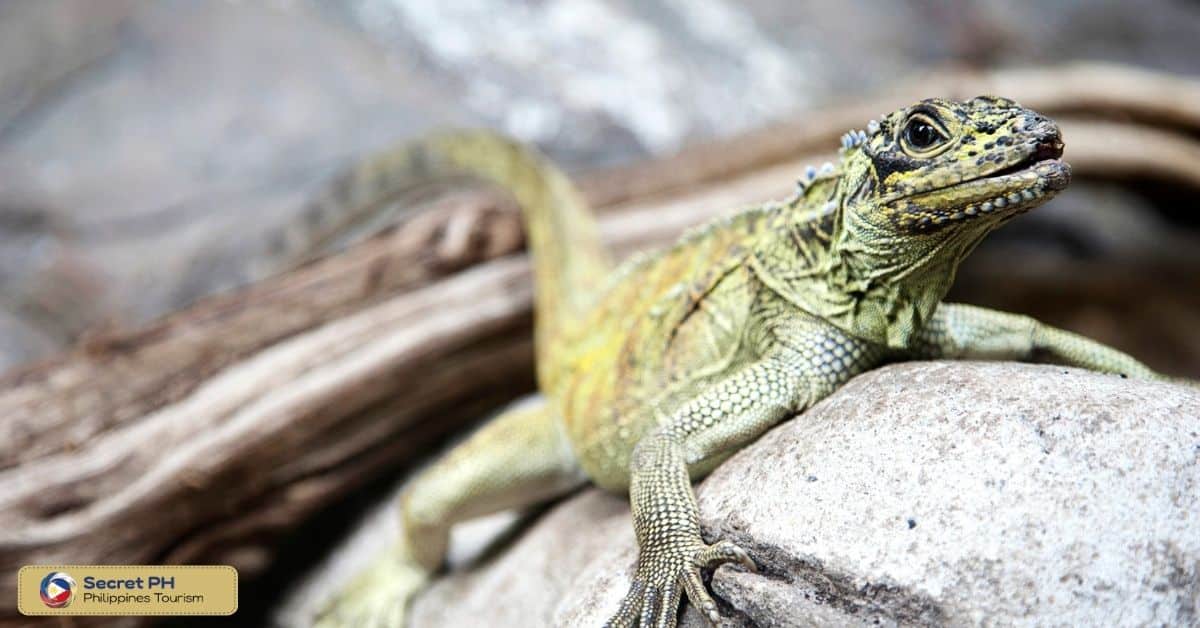
Cultural Significance and Folklore
The Philippine Sailfin Lizard has a significant cultural significance in the Philippines, as they have been revered and respected by local communities for centuries. In some areas, they are considered sacred creatures due to their size and majestic beauty.
They are often associated with fertility and abundance, which is believed to bring good luck and fortune. Additionally, these lizards are believed to symbolize strength and courage, inspiring locals to stand up for what is right.
The Philippine Sailfin Lizard also has a place in folklore and mythology, especially among the Tagalog people. According to legend, these giant lizards were once dragons that lived in the mountains.
They were said to possess magical powers that could bring rain and bring luck to the people. In some stories, they are even said to be capable of transforming into humans.
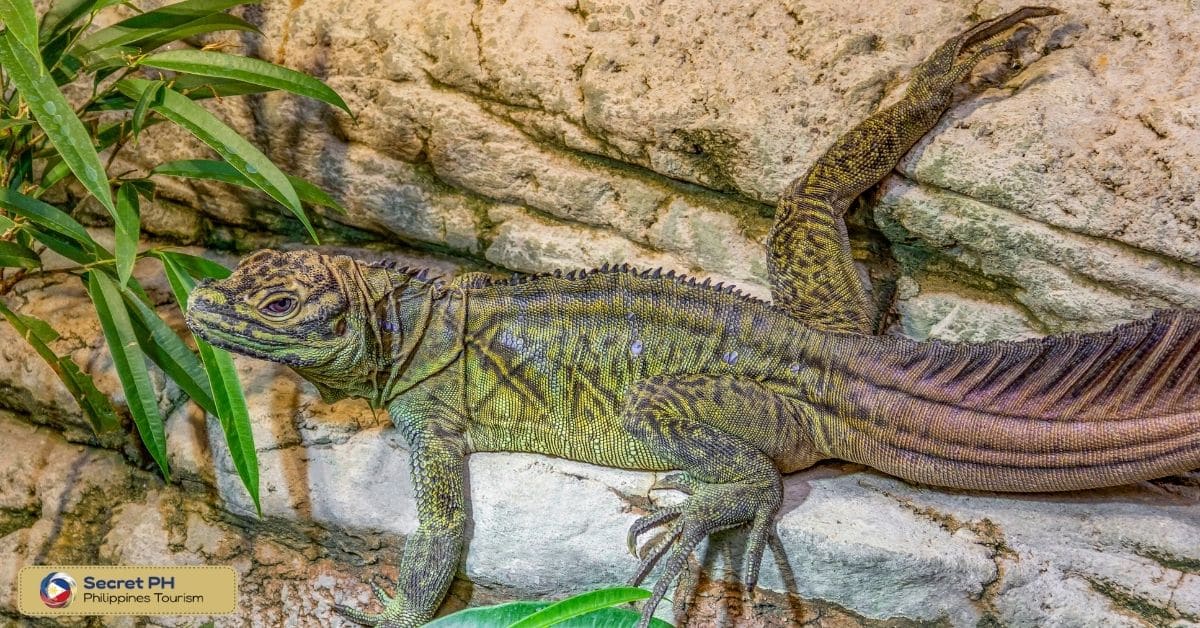
Keeping Philippine Sailfin Lizards as Pets
Keeping Philippine Sailfin Lizards as pets can be a rewarding experience, but it requires a significant commitment and responsibility. These reptiles require specialized care and habitat, and their large size means they need ample space to move around and exercise. It is crucial to do thorough research and consult with experts before deciding to keep a Philippine Sailfin Lizard as a pet.
Providing a suitable habitat, diet, and care is essential to the health and well-being of the Philippine Sailfin Lizard. A large enclosure with plenty of climbing opportunities and a freshwater source is necessary to replicate their natural habitat.
A balanced diet that includes a variety of plant materials and occasional insects or small animals is also necessary. Consistent and thorough care, including regular health check-ups, is crucial to ensuring the longevity and happiness of these amazing creatures.
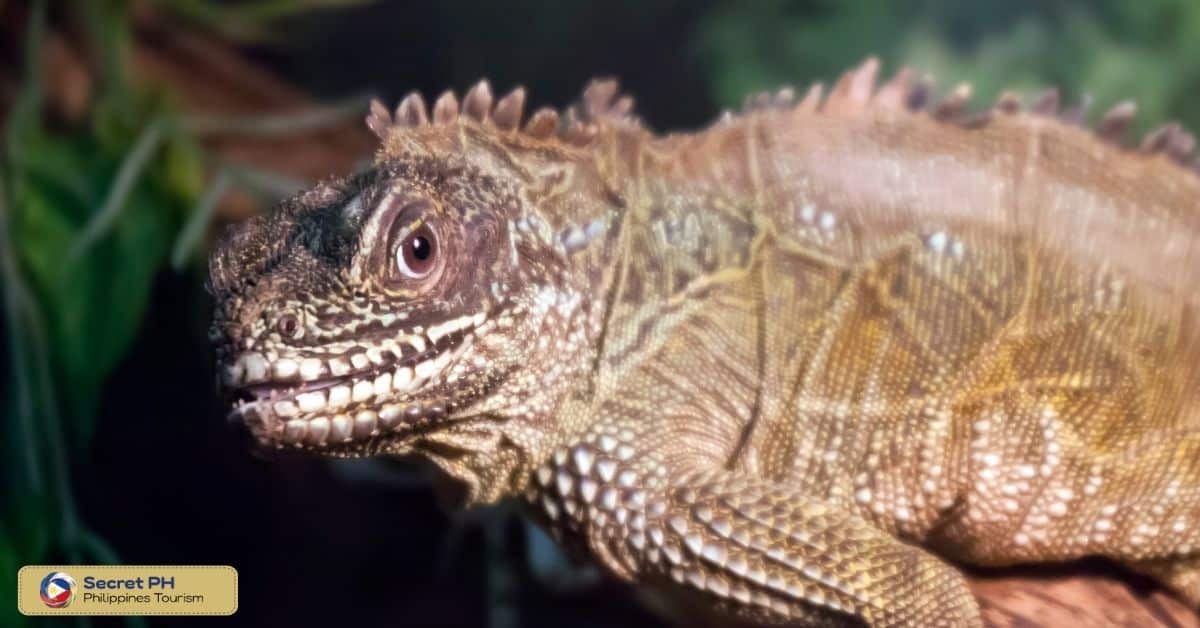
In conclusion
The Philippine Sailfin Lizard is a remarkable species that inhabit the forest and coastal regions of the Philippine Islands. Its impressive size and vibrant coloration makes it an interesting subject for study, but its survival in the wild is threatened due to habitat loss and illegal wildlife trade.
It is important to recognize their unique physical characteristics, diet and feeding habits, behavior and social structure, reproduction and life cycle, cultural significance, and folklore.
As well as the commitment necessary to keep them as pets in order to ensure their survival and protection. Conservation efforts should be taken to protect this species so that future generations can appreciate its beauty and grace.







